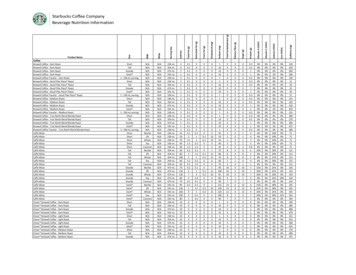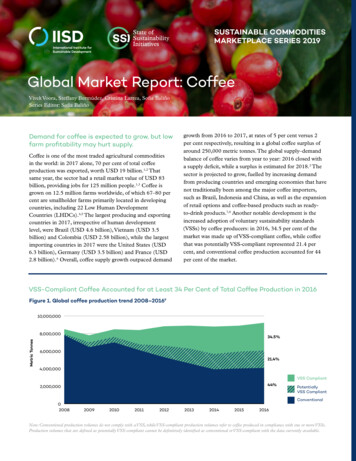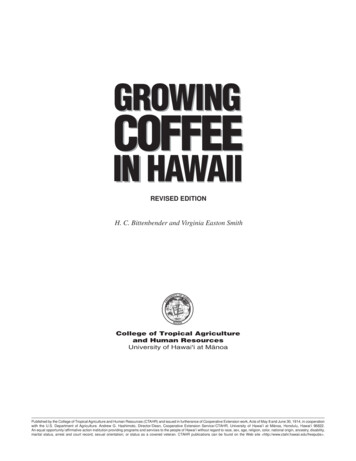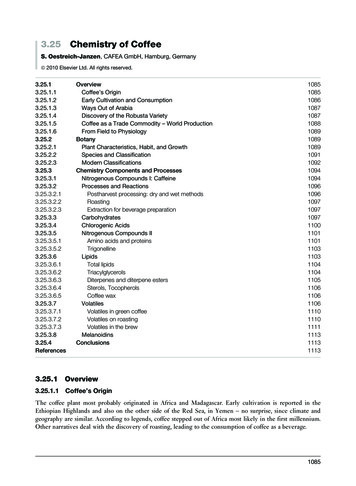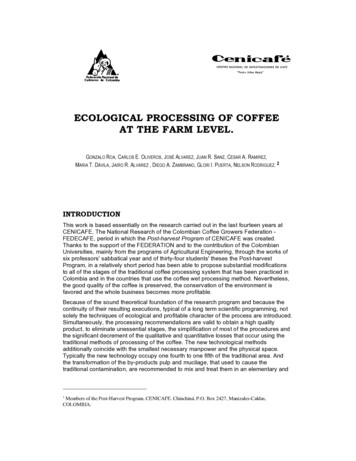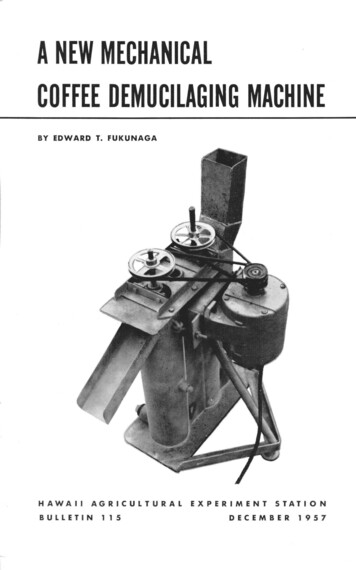
Transcription
ANEW MECHANICALCOFFEE DEMUCILAGING MACHINEBY EDWARD T. TIONDECEMBER1957
CONTENTS,PAGEINTRODUCTION3MUCILAGE ON THE COFFEE BEAN4DEMUCILAGING4Natural Fermentation4Enzyme Digestion6Alkali Hydrolysis .6Mechanical Devices7U rgelles Device7Birnie Pulper and Demucilaging Machine7High-pressure Water Jet Device .8Hess Coffee Washer8.THE H.A.E.S. COFFEE DEMUCILAGING MACHINE99General DiscussionOperation10Capacity13Water Requirement1.5Power Requirement15Beaters16Naked Beans16Damaged BeansSUMMARY1717LITERATURE CITED18THE AUTHOREDWARD T. FUKUNAGA is Associate Agriculturist and Superintendent,Kona Branch Station, Hawaii Agricultural Experiment Station.
A NEW MECHANICALCOFFEE DEMUCILAGING MACHINEBy Edward T. FukunagaINTRODUCTIONThe coffee cherry consists of the outer skin (epidermis), the fleshy pulp( pericarp), and two seeds ( endosperm ) , called "beans" by the coffee trade,in the center of the cherry. These seeds are flat on one side and in eachpair the flat sides face each other.Each bean has two additional layers of protective matter. The layerdirectly in contact with the bean is very thin and papery and it is calledsilver skin ( perisperm). Outside this silver skin is a tough parchment-likematter ( spermoderm) commonly called parchment. In the fresh state theparchment is coated with a thick layer of slimy gel-like substance ( meso carp) commonly called mucilage. The dried coffee bean or seed with all ofits coverings removed is called green coffee by the coffee trade. This greencoffee is roasted and ground to make the retail product.The principal objective in processing coffee at the grower level is thedehydration of the coffee bean to a point where all biological actions ceaseand further processing to the green coffee stage is possible. At this stage,coffee may be stored for several years. The moisture content of the driedbean ranges from 12 to 13 percent.Coffee processing does not involve curing or any chemical change in thecoffee bean itself. Any change in the bean, either by bacterial action or otheragents, is detrimental to the quality of the coffee. There is no treatmentknown that will improve the coffee ( 10). Hence it is imperative that theprocessing, including drying, be completed in as short a time as possible toreduce the chances of the coffee being subjected to action by variousexternal agents.Coffee beans may b e dehydrated either in the cherry state or after thepulp and the mucilage are removed. Drying whole cherry is time-consumingand generally results in poorer coffee; and it is difficult to accomplish whenatmospheric humidity is high. The sugars, pectins, and other materials inthe pulp and mucilage are hygroscopic, hence these materials must bedecomposed b efore the cherry will dry. Normally, enzymes naturallypresent in the coffee cherry ( 10) and microorganisms decompose themucilaginousmatter. Under humid conditions decomposition maycontinue beyond the required degree and undesirable decompositionproducts may be formed. A method has b een devised whereby the cherryis treated with either pectic enzymes or a combination of these enzymesand a preparation containing cellulases, hemicellulases, and gummases toaccelerate the digestion of the mucilaginous matter before drying ( 9).3
Drying whole cherry is usually done only in regions where low at mospheric humidity prevails during the coffee harvesting season, as inBrazil. Even there, however, much coffee is ruined when unseasonal rainsoccur.Coffee processed by drying whole cherry is called "natural coffee" andusually commands a lmver market price" than coffee processed by the wetmethod described below.In the wet method, the pulp and mucilage are removed before drying.The bean, however, is still encased in the parchment and silver skin. Pulpedand deslimed beans can be dried more rapidly than whole cherry becausethe pulp, which is 80 percent moisture ( 6), and the mucilage, which ishighly hygroscopic, are removed. The present discussion is concerned withthe removal of this mucilage.Mucilage on the Coffee BeanThe mesocarp, composed of parenchyma cells, is variously called muci lage, slime, honey ( 5), pectic-gel (1), saccharine matter ( 12) , lees ( 7, 13),residual pulp ( 7), mucous integument ( 2), etc. It is described as gummyor slimy. Mucilage is the preferred term.The mucilage adheres tightly to the parchment and cannot be freed bysimple washing or by centrifuging. It has a large water-holding capacity(10). This property can be deduced from the great reduction in volume ofmucilage when freshly pulped coffee is dried under artificial heat. Thedried mucilage is very hygroscopic and becomes sticky when the bean isremoved from the drying oven. It absorbs moisture from the air so rapidlythat artificially dried mucilage-covered beans cannot be weighed even on atorsion balance unless the bean is confined in an airtight container.Thus it becomes evident that the mucilage must be removed ordecomposed before the bean can be dried. In the dry method the enzymesnaturally present in the coffee ( 10) and microorganisms break down themucilage. This breakdown can be hastened by artificially adding pecticand other enzymes to the cherry (9) as pointed out above. In the wetmethod the mucilage is removed from the pulped beans before drying.DEMUCILAGINGThere are four general methods used today to remove the mucilage frompulped coffee beans. These are natural fermentation, artificial enzymedigestion, alkali hydrolysis, and mechanical demucilaging in which themucilage is rubbed off by friction or high-pressure water jets.Natural FermentationThis is the most widely used method and the only method used com mercially for demucilaging coffee until recent times. In this method thepulped coffee bean is placed in vats with or without additional water, and00ne exception occurred for a short time immediately after the 1953 frost in Brazil.4
the mucilage is allowed to ferment spontaneously by means of the naturalenzyme present in the coffee bean; and, also, by means of enzymes producedby bacteria, molds, and yeast which occur naturally. The process requiresfrom 10 to 100 hours ( 5) depending upon the conditions. 0 The speed offermentation depends upon the temperature and the concentrations of themucilage and microorganisms. Hence, fermentation is accelerated if noadditional water is added to the pulped beans and optimum temperaturesfor bacterial activity are maintained.Fermentation is an exacting process. Since the mucilage containscarbohydrates and proteins, and various types of microorganisms areinvolved, different types of fermentation can be occurring simultaneously.The first fermentation which occurs is an alcoholic one in which the carbo hydrates are converted into alcohols ( 5). This is followed by aceticfermentation. The latter can be retarded by keeping the fermentationtemperatures low; however, low temperatures also retard alcoholic fermen tation. Since the mucilage also contains proteins, putrefaction may also takeplace. Putrefaction is accelerated by high temperatures.In fermenting the mucilage, it is imperative that the process be stoppedwhen the alcoholic fermentation has progressed sufficiently to loosen themucilage from the parchment. If the fermentation is allowed to continue,there is danger of acetic fermentation and putrefaction progressing too far.Products of these processes will be absorbed by the coffee bean, resultingin "sour beans" and beans with foul odors.In some practices the depulped coffee is placed in a large volume ofwater. The water is changed from time to time. Under such conditions,the temperature does not rise to the point where acetic fermentation begins,since acetic fermentation takes place at a higher temperature than alcoholicfermentation. However, the alcoholic fermentation is also retarded con siderably by the low temperature, high dispersal of microorganisms, an lhigh dilution of nuh·ients. Fermentation under such conditions is safer asfar as the coffee is concerned, but it takes from 72 ( 3) to 100 hours ( 5) forthe mucilage to break down completely. Such prolonged processes increasethe cost of processing coffee.As has been shown above, the fermentation process is exacting andinvolves risks of quality deterioration. It also requires considerable outlayof space and equipment for fermentation vats. This becomes especiallyexpensive where slow fermentation methods are used.Another consideration, which became apparent after quick demucilagingmethods were developed, is the loss in weight the coffee undergoes duringthe fermentation. It is well known that plant tissue respires as long as it isalive. The respiration rate is directly proportional to the temperature withincertain limits. It is generally most rapid when the moisture content of thetissue is highest. In coffee beans, the respiration is most rapid immediatelyafter pulping ( 11 ) . Hence, the most active respiration takes place duringthe fermentation process.00ne processor in Hawaii completes the natural fermentation in three hours.5
In the respiration process, the carbohydrates and other organic matterare converted to carbon dioxide which is lost to the atmosphere. Thus, aslong as the respiration continues, the coffee bean is losing weight.Jones and Bayer ( 11) found that coffee processed without naturalfermentation weighed as much as 3.9 percent heavier than coffee dried afternatural fermentation. Bannell (1) estimates that the average savings inweight would be about 3 percent if fermentation is eliminated.Several schemes have been devised to demucilage beans, avoidinguncontrolled elements, that is, naturally occurring enzymes and micro organisms.All of the methods devised reduce the time of demucilaging. The alkalihydrolysis and mechanical methods described below permit the demucilag ing to be carried out in a continuous operation synchronized with thepulping. The cherry enters the pulper and the bean emerges from thedemucilaging device ready for drying.The quality of the coffee demucilaged without fermentation has beenproven equal or superior to coffee processed with fermentation ( 4, 11, 14).This does not imply that quick demucilaging will improve the quality, butit will eliminate the likelihood of fermentation products spoiling the quality.Enzyme DigestionOne of the first methods devised to eliminate fermentation and onewhich has attained some popularity is that which employs enzymes.Pectic enzymes when added to the pulped coffee will hasten the break down of the mucilage. One commercial product is now being manufacturedfor this purpose. 0It is claimed ( 10) that the mucilage can be decomposed in less than anhour when this commercial preparation is stirred into the fermentation vatat the rate of 0.2 percent of the pulped bean and the temperature main tained at 75 to 85 F. However, on account of the high cost of the enzymepreparation, a 0.025 percent concentration is recommended in actualpractice. This will prolong the digestion time to 5 to 10 hours dependingupon the temperature maintained.Although this method provides some measure of control, it still requiresfermentation vats which occupy considerable space on large plantations.Since coffee harvested during the day is normally pulped during the sameafternoon and evening, the 5- to 10-hour digestion time necessitates w,,shingduring the night. From the labor standpoint, the natural fermentation,which is usually completed in 12 to 16 hours, is more convenient as thewashing need not be done until the following day.Alkali HydrolysisDilute solutions of strong alkali, caustic soda or caustic potash, havebeen used to clean pulpy seeds such as the tomato seed. The method wasnot applied to coffee until about 1952.0Sold under the trade name "Benefax."6
In this method the freshly pulped coffee bean is agitated in a solution ofcaustic soda. Shuhart used a 6 percent solution ( 14) while Jones and Bayerused a 2 percent solution ( 11 ). Jones and Bayer also used wood ash andlime. In tests run at the Kona Branch Experiment Station, hand-stirring amixture of one volume of a 2 percent sodium hydroxide solution with anequal volume of freshly picked and pulped coffee did not result in completemucilage breakdown. However, when a 6 percent solution was used, themucilage breakdown occurred in about one minute. The resulting beancan then be washed clean of the mucilage.The parchment of the bean treated with the 6 percent sodium hydroxidesolution was dark yellow; however, the green bean itself was normal inappearance. Shuhart ( 14) has already reported that the cupping qualityof the alkali-demucilaged coffee was superior to fermented coffee. Germina tion tests conducted at the Kona Branch Station proved that the 6 percentsodium hydroxide treatment did not impair the viability of the seed.Mechanical DevicesThe enzyme digestion and alkali treatment not only require the purchaseof the material but also require precise adjustments of the strengths of therespective solutions in order to achieve the most economic use of thematerial. The strong alkali used is also corrosive and requires carefulhandling. Hence, these methods are not ideal for small farms even if thecost of the material were nominal.It has been known for many years that the mucilage on the coffee beancan be removed mechanically and several such devices have beendeveloped.Urgelles DevicePatent was granted for this device in 1912 (15). In this device, sand orsawdust is first imbedded into the mucilage layer of the freshly pulpedbean. The bean is then subjected to rubbing action. The mucilage removalis accomplished by the abrasive action of the sand or sawdust. This machineis complicated; it involves imbedding the abrasive on the two sides of thebean, rubbing off the mucilage, and separating the abrasive and mucilagefrom the bean.Birnie Pulper and Demucilaging MachinePatent for this machine was granted in 1929 ( 2). This machine consistsof two concentric cylinders mounted horizontally on a common shaft. Theouter cylinder is stationary while the inner cylinder rotates. The innercylinder is ribbed to increase friction. Coffee cherry or pulped coffee isforced into the space between the two cylinders by the screw action of afeeding worm.This machine may be used to remove both the pulp and the mucilage inone continuous operation, or to remove mucilage of prepulped beans. Asthe inner cylinder rotates, the cherry is forced through the space betweenthe two cylinders. The cherry is first crushed and the pulp rubbed off the7
bean. As the rubbing continues, the mucilage is also removed. The pulpis broken into small pieces during the rubbing process. During theprocess, water is forced into the inner cylinder through the hollow spindle.This water escapes into the space between the two cylinders through smallholes provided for this purpose in the inner cylinder. The pulp and muci lage are then carried by this water through holes provided in the outercylinder. The bean is forced toward the outlet end of the device bypressure from the incoming beans. Hence the machine must be fullycharged ( with beans) at all times. The beans remaining in the machineafter each run will not be completely demucilaged.This machine is now manufactured commercially and is sold undervarious trade names." The chief disadvantage of this machine is its highpower requirement. A machine having a capacity of 3,300 pounds cherryper hour requires 14 h.p., according to specifications in one catalogue.High-pressure ·water Jet DeviceA patent for this device was granted to Pellas and Kraut in 1941 ( 13).According to the inventor, a fluid pressure up to 300 p.s.i. is "desirable" todemucilage some "types of berries" although 100 p.s.i. is satisfactory underordinary conditions. Such a machine obviously requires considerableamounts of water and is not suitable for localities where water supply islimited. It also requires high water head or considerable power to developsuch high pressures.Hess C offce 1asherIn 1955, a patent was granted to H. L. Hess for a demucilaging machine( 7).This machine consists of several square compartments arranged inseries. The compartments have a common floor which moves back andforth along the line of the compartments. A baffie plate is welded to thefloor of each compartment.Pulped coffee is fed into one end-compartment. As the baffie moves backand forth, the mass of beans is also rocked back and forth, causing the beansto rub against each other and also against the walls of the compartment.Provisions are made for the beans to move from this end-compartment intothe next, and so on. The beans receive the same treatment in each compart ment. Water is sprinkled over the beans and the freed mucilage allowedto drop through holes provided in the floor.As the coffee moves from one compartment to the other it becomescleaner, and when the machine is properly adjusted, the coffee emerges fromthe end-compartment completely freed of the mucilage.Although this machine does a good job of demucilaging the coffee bean,the reciprocal action of the principal moving part requires rigid construe"E. H. Bental & Co. of Essex, England, is marketing a unit called "Aquapulpa." Hen schell Maschinenbau of Hamburg, Germany, is manufacturing one called the "Raoeng Pulper."8
tion and extra power merely to overcome the kinetic energy of the movingpart. Such a device must necessarily be of heavy construction and must beanchored to a solid foundation or suspended on special mountings in orderto prevent the transmission of the heavy vibrations.THE H.A.E.S. DEMUCILAGING MACHINEMechanical demucilaging of coffee beans has been under considerationat the Hawaii Agricultural Experiment Station since 1953. Centrifugingwas first tried, but the mucilage adhered to the bean so tightly that it couldnot be removed in ordinary centrifuges. Rubbing a batch of beans by handdid remove the mucilage but the operation was too slow and too tiring.Beating a batch of b eans with a rotary eggbeater was also tried, but thebeans stuck between the blades. However, when a batch of pulped beanswas beaten with only one set of rotating blades of a household food mixer athigh speed, the beans were completely demucilaged in about 3 minutes.Several batches of beans were demucilaged in this manner, washed, sun dried, and milled to remove the parchment cover. No physical damage tothe green bean was noticeable upon close examination.In order to make the operation continuous, a gravity feed apparatus wasdevised. This feeding is unique among coffee demucilaging devices so fardeveloped. In all the devices mentioned above, the coffee is forced hori·zontally through the devices by mechanical force.The apparatus developed here is essentially a "U" tube. Any liquidpoured into one arm of the "U" tube will rise to a corresponding height inthe other arm. Since the specific gravity of freshly pulped coffee beans isonly slightly greater than that of water, water movement through the tubeswill carry the beans with it provided the water flow is not too slow.Figures 2 and 4 show a cutaway diagram of the demucilaging machineTube A ( fig. 2) is the feeder arm into which coffee and water are funnelledsimultaneously. This tube is made slightly longer than tube B. Tube B,the mixer tube, encloses a rotary beater similar in principle to the beaterin a household food mixer, except that only one set of blades is used. Themixer tube is long enough to entirely enclose the beater blades with aninch of space between the top of the beater and the spout S. If the beateris exposed at the spout, there will be considerable splashing during theoperation.The beater blades are }4-inch steel rods welded to a %-inch steel shaft,as shown in figure 2. The width of the blades is such that there is a 1-inchclearance between the outer edges of the blades and the wall of the mixertube. Several tie-rods are welded between the blades and the shaft toprevent the blades from spreading out by centrifugal action during theoperation. These rods also increase the rubbing surface of the beater.The beater is mounted in the center of the mixer tube. It may bemounted with two ball bearings above the tube as shown in figure 2, orwith one bearing above and another at the bottom of the tube as shown infigure 4. The former system of mounting requires a perfectly balanced9
Figure I.Single unit demucilaging machine.beater, but lubrication becomes simpler and ordinary ball bearings may beused. If a bearing is to be used at the bottom of the mixer tube, specialwater-lubricating bearings or sealed bearings should be used there.Power for rotating the beater is from an electric motor mounted asshown in figure 1 via appropriate pulleys and belt.Several Js-inch steel rods are welded on the inside surface of the mixertube. These rods act as ribs to induce stirring action. The rods are arrangedin a slight spiral form in such a direction as to give the swirling mass insidethe tube a slight upward thrust. However, the machine will work even ifthe rods are welded straight up and down.OperationAfter the blades are set in motion, freshly pulped coffee direct from thepulper, together with a constant How of water regulated by a gate valve, is10
AFigure 2.Cutaway diagram of coffee demucilaging machine.funnelled into the feeder tube. As the coffee suspension rises in this tube,it also rises in the mixer tube. While the suspension is traveling up the mixertube, the mucilage is beaten off by the rapidly moving blades of the beater.The rate of travel of the suspension through the tubes will dependessentially upon the rate of water fed into the feeder tube. The amount ofcoffee fed into the feeder tube has less effect on the fl.ow. If coffee is fedtoo rapidly in comparison to the water, it will pile up in the feeder tubeand the hopper attached to this tube. If water is fed too rapidly into thefeeder tube the coffee will travel through the tubes too rapidly, resulting inincomplete mucilage removal. Hence the regulation of the water fl.ow isvery important.The demucilaged coffee spilling out of the spout ( fig. 2, S) is then con veyed or flumed to a shaker with a screen bottom where the mucilage andexcess water are shaken off. Fresh water sprinkled on the coffee beans on11
Figure 3. Tandem unit. Power is obtained from one motor.the shaker will further wash off any mucilage adhering to the beans. Thestandard shaker now used on coffee farms in Hawaii may be used. Theseshakers are so arranged that the coffee travels directly to the drying plat form while being shaken. The coffee is then ready for drying.The machine is easily cleaned. After the pulping is completed and nomore coffee is fed into the demucilaging machine, the operation is continuedfor a few minutes with only water being fed into the feeder tube. Whencoffee beans stop coming out of the outlet spout, there will be very littlecoffee left in the machine. The operation is then stopped and the tubes are12
AFigure 4.Cutaway diagram of two demucilaging units in a series.drained through a bung provided at the bottom of the mixer tube onto ascreen to catch any coffee beans still left in the machine.CapacityThe capacity of the machine depends upon the diameter and length ofthe mixer tube and the speed of rotation of the beaters. To double thelength of the tubes (feeder and mixer), two sets of tubes may be connectedin tandem as shown in figures 3 and 4. This will make the machine morecompact and easier to mount. In this arrangement ( see fig. 4) the coffee13
suspension is fed into tube A. The suspension then rises in tube B, spillsinto tube C, and rises through tube D.The mass of pulped beans must be subjected to the rapid stirring actionof the beater blades for a definite length of time depending upon the periph eral velocity of the blades. The greater the velocity of the blades p assingthrough the coffee mass, the faster will be the demucilaging.The peripheral velocity of the beater is directly proportional to the speedof rotation (r.p.m.) and the peripheral diameter. Hence, in order to main tain a constant peripheral velocity, the rotation speed must be variedinversely to the peripheral diameter for different size beaters.Since the coffee must be in the apparatus for a definite length of timefor a given peripheral velocity of the beater, either the diameter or thelength of the mixer tube must be varied in order to change the capacity.The first experimental model consisted of a 4-inch ( inside dimension)mixer tube enclosing a 4-blade beater, 12 inches in length and 2 inches inperipheral diameter. The mixer tube extended 3 inches below and 4 inchesabove the beater. The speed of rotation was set at motor speed ( 1725r.p.m. ). The feeder tube was 3 inches in diameter and equipped with afunnel to facilitate feeding. Freshly pulped coffee was fed by hand. Waterwas piped into the feeder tube through a rubber hose. After several lotswere run, the capacity was estimated at approximately 5 bags cherry perhour.When the mixer tube was enlarged to 6 inches in diameter and thebeater enlarged to 4 inches in peripheral diameter by 24 inches in length,and rotated at approximately 860 r.p.m., the capacity was doubled. Whenthe speed of rotation of the beater was increased, more coffee could bedemucilaged in a given time, but it was found that a considerable numberof coffee beans emerged naked, i.e., with their parchment cover completelyremoved. However, it became evident later that the parchment removalwas caused by rough edges on the beater and ribs in the tube. These roughedges were formed in the welding process. In a subsequent model it wasfound that the speed of rotation could be increased without causing anyincrease in naked-bean output after the demucilaging machine had been inuse for some time.In order to increase the capacity of the apparatus, two 6-inch X 24-inch( effective length, i.e., the length of the beaters) units were connected intandem as shown in figures 3 and 4. This in essence has the same effect asdoubling the length of the beater. The coffee presumably could be passedthrough the machine twice as fast with the same degree of effectiveness.Tests have borne out this fact. However, a capacity of 20 bags cherry perhour was still insufficient since most pulpers used on coffee farms in Hawaiihave capacities of approximately 30 bags cherry per hour.The machine was run at a beater speed of 860 r .p.m. until about 150bags of cherry were run through it, then the speed of rotation of bothbeaters was increased. The r.p.m. of the first beater ( in tube B, fig. 4) wasraised to approximately 1000, and that of the second ( in tube D, fig. 4) to14
1200. Surprisingly, the percentage of naked-bean output did not increase.This is attributed to the wearing-down of the jagged spots on the beater andthe ribs inside the mixer tube. At these speeds of rotation, it was foundthat the pulper to which the machine was connected could be operated atits maximum capacity. Timing studies showed that the pulper was pulping2,900 pounds of cherry per hour. This was the maximum capacity of thepulper used, and in no way established the maximum capacity of the demu cilaging machine. However, from observations it could reasonably beassumed that the demucilaging machine could at least demucilage coffeeemerging from a pulper pulping 3,000 pounds ( 30 bags) of cherry per hour.Water RequirementSince, as pointed out above, the rate of flow of water regulates the rateof flow of the coffee beans through the demucilaging machine, the regula tion of water flow depends upon the Bow rate which will give completedemucilaging and at the same time prevent coffee pile-up in the feeder tube.This is done by varying the water flow into the feeder tube while the coffeeis being fed from the pulper until coffee bean pile-up in the feeder tube isnoticed. At this point the water flow is increased slightly so that coffeepile-up in the feeder tube is barely prevented. If the coffee emerges fromthe machine incompletely demucilaged, either the pulping rate must bereduced or the speed of revolution of the beaters increased. If the coffeeemerges completely demucilaged, the water flow may be increased as longas the coffee emerges satisfactorily demucilaged. Excess water is notentirely wasted since the more water used in the machine the less viscousthe mucilage will be when it is discharged, and the subsequent washingoperation will be easier. Excess water will insure no coffee pile-up in thefeeder tube.Measurements have shown that the minimum water flow necessary forthe demucilaging machine described above is approximately 0.8 gallons( 3100 ml.) per minute. Under normal operation 1-1.5 gallons per minuteis being used for demucilaging coffee emerging from the pulper pulping2,900 pounds of cherry per hour. Since the coffee is being demucilagedsatisfactorily even with this excess water flow, it is evident that the machineis not being run at maximum capacity and it can at least take care of pulperspulping at 3,000 pounds of cherry per hour.Considerably more water is needed to wash the mucilage off the beanafter it emerges from the demucilaging machine. Here the amount willdepend upon the type and efficiency of the washing device. At the KonaBranch Experiment Station the coffee emerges from the demucilagingmachine onto a shaker where excess mucilage is shaken off and water issprinkled over the coffee as it moves along the shaker.Power RequirementA 2 h.p. motor is sufficient to operate the tandem machine ( figs. 3 and 4)with beaters rotating at 1000 and 1200 r.p.m. in the first and second mixer15
tubes, respectively, and demucilaging at the rate equivalent to 3,000 poundscherry per hour.BeatersSeveral types of beaters have been tried. Four- and six-bladed beatersof the types shown in figure 4 were equally satisfactory. It was found thatthe tie-rods radiating from the shaft and welded to the b
coffee is roasted and ground to make the retail product. The principal objective in processing coffee at the grower level is the dehydration of the coffee bean to a point where all biological actions cease and further processing to the green

